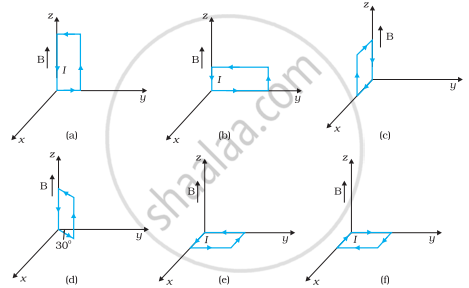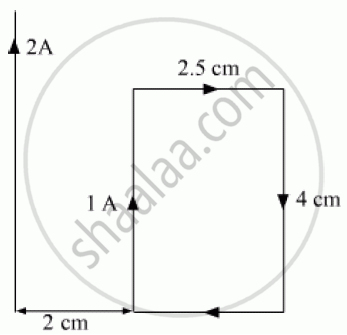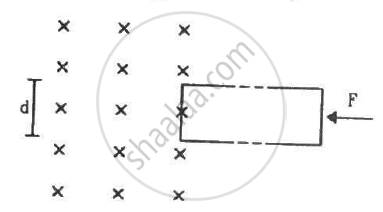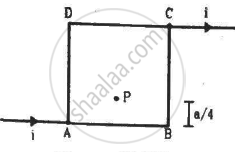Advertisements
Advertisements
Question
A uniform magnetic field of 3000 G is established along the positive z-direction. A rectangular loop of sides 10 cm and 5 cm carries a current of 12 A. What is the torque on the loop in the different cases shown in fig.? What is the force on each case? Which case corresponds to stable equilibrium?

Solution
Magnetic field strength, B = 3000 G = 3000 × 10−4 T = 0.3 T
Length of the rectangular loop, l = 10 cm
Width of the rectangular loop, b = 5 cm
Area of the loop,
A = l × b = 10 × 5 = 50 cm2 = 50 × 10−4 m2
Current in the loop, I = 12 A
Now, taking the anti-clockwise direction of the current as positive and vice-versa:
(a) Torque, `vecτ = "I"vec"A" xx vec"B"`
From the given figure, it can be observed that A is normal to the y–z plane and B is directed along the z-axis.
∴ τ = `12 xx (50 xx 10^-4)hat"i" xx 0.3 hat"k"`
= `-1.8 xx 10^-2 hat"j" "N m"`
The torque is 1.8 × 10−2 N m along the negative y-direction. The force on the loop is zero because the angle between A and B is zero.
(b) This case is similar to case (a). Hence, the answer is the same as (a).
(c) Torque, `τ = "I"vec"A" xx vec"B"`
From the given figure, it can be observed that A is normal to the x–z plane and B is directed along the z-axis.
∴ τ = `-12 xx (50 xx 10^-4)hat"j" xx 0.3 hat"k"`
= `-1.8 xx 10^-2 hat"i" "N m"`
The torque is 1.8 × 10−2 N m along the negative x-direction and the force is zero.
(d) Magnitude of torque is given as:
|τ| = IAB
= 12 × 50 × 10−4 × 0.3
= 1.8 × 10−2 N m
Torque is 1.8 × 10−2 N m at an angle of 240° with positive x-direction. The force is zero.
(e) Torque, `τ = "I"vec"A" xx vec"B"`
= `(50 xx 10^-4 xx 12) hat"k" xx 0.3 hat"k"`
= 0
Hence, the torque is zero. The force is also zero.
(f) Torque, `τ = "I"vec"A" xx vec"B"`
= `(50 xx 10^-4 xx 12) hat"k" xx 0.3 hat"k"`
= 0
Hence, the torque is zero. The force is also zero.
In case (e), the direction of `"I"vec"A"` and `vec"B"` is the same and the angle between them is zero. If displaced, they come back to an equilibrium. Hence, its equilibrium is stable.
Whereas, in case (f), the direction of `"I"vec"A"` and `vec"B"` is opposite. The angle between them is 180°. If disturbed, it does not come back to its original position. Hence, its equilibrium is unstable.
APPEARS IN
RELATED QUESTIONS
A square coil of side 10 cm consists of 20 turns and carries a current of 12 A. The coil is suspended vertically and the normal to the plane of the coil makes an angle of 30° with the direction of a uniform horizontal magnetic field of magnitude 0.80 T. What is the magnitude of torque experienced by the coil?
In a chamber, a uniform magnetic field of 6.5 G (1 G = 10–4 T) is maintained. An electron is shot into the field with a speed of 4.8 × 106 m s−1 normal to the field. Explain why the path of the electron is a circle. Determine the radius of the circular orbit. (e = 1.5 × 10–19 C, me = 9.1 × 10–31 kg)
A rectangular loop of wire of size 2.5 cm × 4 cm carries a steady current of 1 A. A straight wire carrying 2 A current is kept near the loop as shown. If the loop and the wire are coplanar, find the (i) torque acting on the loop and (ii) the magnitude and direction of the force on the loop due to the current carrying wire.

A rectangular loop of size l × b carrying a steady current I is placed in a uniform magnetic field `vecB`. Prove that the torque `vectau`acting on the loop is give by `vectau =vecm xx vecB,`where `vecm` is the magnetic moment of the loop.
The rectangular wire-frame, shown in figure, has a width d, mass m, resistance R and a large length. A uniform magnetic field B exists to the left of the frame. A constant force F starts pushing the frame into the magnetic field at t = 0. (a) Find the acceleration of the frame when its speed has increased to v. (b) Show that after some time the frame will move with a constant velocity till the whole frame enters into the magnetic field. Find this velocity v0. (c) Show that the velocity at time t is given by
v = v0(1 − e−Ft/mv0).

Figure shows a square loop of edge a made of a uniform wire. A current i enters the loop at the point A and leaves it at the point C. Find the magnetic field at the point P which is on the perpendicular bisector of AB at a distance a/4 from it.

Consider the motion of a charged particle in a uniform magnetic field directed into the paper. If velocity v of the particle is in the plane of the paper the charged particle will ______.
A rectangular conducting loop consists of two wires on two opposite sides of length l joined together by rods of length d. The wires are each of the same material but with cross-sections differing by a factor of 2. The thicker wire has a resistance R and the rods are of low resistance, which in turn are connected to a constant voltage source V0. The loop is placed in uniform a magnetic field B at 45° to its plane. Find τ, the torque exerted by the magnetic field on the loop about an axis through the centres of rods.
- Assertion (A): The deflecting torque acting on a current-carrying loop is zero when its plane is perpendicular to the direction of the magnetic field.
- Reason (R): The deflecting torque acting on a loop of the magnetic moment `vecm` in a magnetic field `vecB` is given by the dot product of `vecm` and `vecB`.
